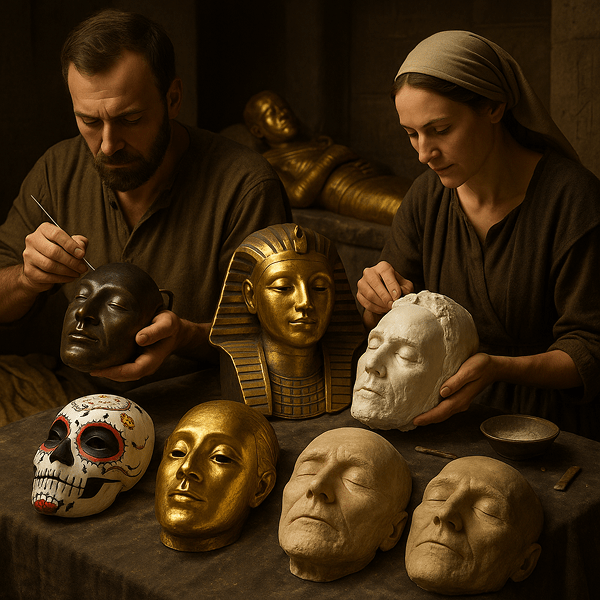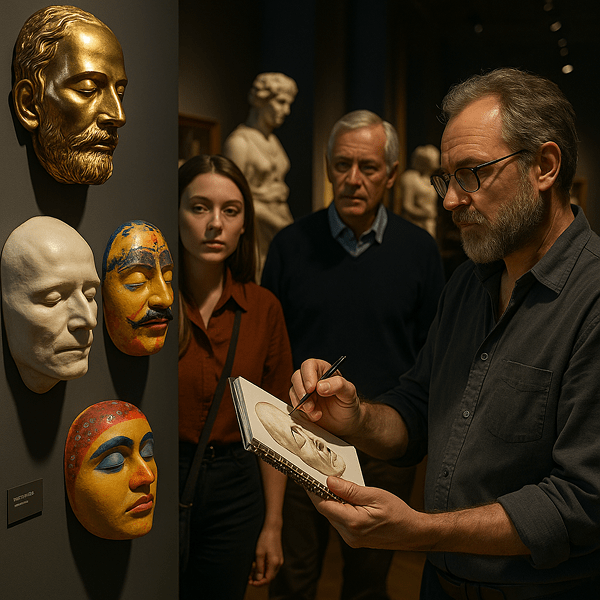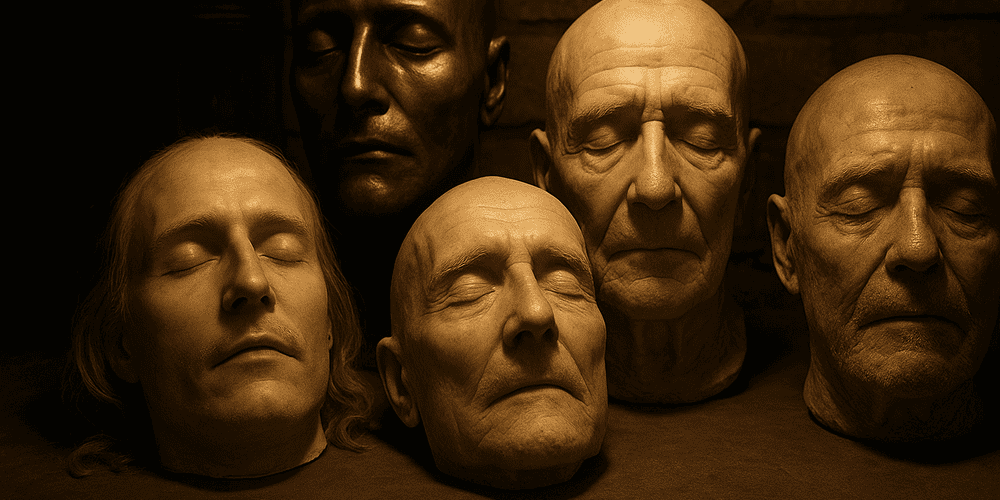Funerary Death Masks are among the most evocative and enduring artifacts of world funerary traditions, providing a hauntingly personal link between the living and the dead. Unlike theatrical or ritual masks, Death Masks are typically created directly from the face of the deceased, capturing their unique features with striking realism. These masks can be made from a variety of materials — plaster, wax, bronze, or even gold — and are distinguished by their lifelike detail, closed or serene eyes, and subtle expressions that preserve the final image of the departed. Death Masks have been found in many cultures and regions, from Ancient Egypt and Mycenaean Greece to Renaissance Europe and beyond, spanning a time frame from the Bronze Age to the early twentieth century.
Historical Origins of Death Masks
The history of Death Masks stretches back thousands of years, encompassing both practical and spiritual motivations. The term “death mask” refers to a cast or impression taken from the face of the deceased, rather than a stylized or symbolic representation. The etymology comes from the Old English “deað” (death) and “mask,” a word likely of Arabic origin (“maskhara,” meaning fool or buffoon), which evolved in European languages to signify a covering or likeness. Early examples of funerary masks include the gold Mycenaean Funeral Masks (such as the Mask of Agamemnon), crafted to honor elite individuals and ensure their identity in the afterlife. In Ancient Egypt, Mummy Masks served a similar purpose, fashioned from gold, cartonnage, or painted plaster to both protect and immortalize the deceased. In later European history, plaster and wax death masks became popular among nobles, artists, and intellectuals, serving as both mementos and sources for posthumous portraiture. The evolution of death mask design traces advancements in materials, artistic techniques, and attitudes toward death and remembrance.
Cultural Significance and Symbolism of Death Masks
Death Masks hold deep symbolic resonance in their respective cultures. In many societies, the mask was believed to preserve the soul, protect the body, or facilitate the journey to the afterlife. For the Egyptians, the funerary mask presented the deceased in an idealized, divine form, linking them to gods like Osiris. In Ancient Greece, gold masks conferred status and ensured that the spirit would be recognized among ancestors. In Europe, the death mask became a revered keepsake, used to create busts, paintings, or as a relic for family and admirers. Myths and legends often imbued masks with magical properties — some believed that the mask could ward off evil spirits or preserve the memory and influence of the deceased. Socially, death masks reinforced hierarchies, commemorating rulers, artists, and thinkers, and serving as a tangible connection to the past.
Materials and Craft Techniques of Death Masks
The technique of making Death Masks varies by era and region but generally involves taking a direct impression of the deceased’s face. In ancient cultures, such as Egypt or Mycenae, masks were crafted from gold, cartonnage, or painted plaster, molded over the features of the deceased or sculpted in their likeness. In Europe, the development of plaster allowed for quick, detailed impressions to be made soon after death, followed by casting in wax or bronze for permanence. Artisans used natural pigments, gilding, or inlay to enhance the mask’s realism and beauty. Decorative motifs, such as headdresses, jewelry, or religious symbols, reflected the individual’s status and beliefs. Regional differences are evident: Russian and French death masks from the 18th and 19th centuries display remarkable detail and artistry, while in Latin America, masks may be brightly painted and used in Day of the Dead celebrations. Color symbolism — gold for divinity, white for purity, black for mourning — adds additional meaning to each mask.

Functions and Uses of Death Masks
Death Masks served a variety of ritual, commemorative, and artistic functions. In ancient funerary contexts, they were placed over the face of the deceased to ensure recognition and spiritual protection. In Europe, death masks became prized relics, displayed in family homes, museums, or libraries as symbols of remembrance and respect. Artists often used death masks as references for posthumous portraits or sculptures, ensuring accuracy and lifelike detail. In some cultures, masks were used in funeral processions, religious ceremonies, or as part of ancestor worship. Over time, the practice of making death masks declined with changes in cultural attitudes toward death, advances in photography, and new methods of memorialization. Today, Death Masks are primarily found in museum collections, serving as powerful educational and historical artifacts. There is little evidence of their use in theater or festivals, as their purpose is inherently funerary and commemorative. In the context of ancient funerary traditions, Mummy Masks offer a parallel example of masks serving both protective and commemorative roles.
Regional Variations of Death Masks
Death Masks display striking regional variation, shaped by local customs, materials, and beliefs. In Ancient Egypt, masks ranged from golden royal portraits to painted cartonnage for commoners. Greek and Mycenaean masks were often crafted from hammered gold and placed in elite tombs. In Renaissance and Enlightenment Europe, plaster and wax masks captured the likenesses of kings, poets, composers, and military leaders — famous examples include those of Dante, Napoleon, Beethoven, and Blaise Pascal. In Russia, death masks were used for writers and artists, while in Central and South America, masks were integrated into vibrant funerary festivals. Each region’s tradition reflects local attitudes toward death, remembrance, and the afterlife, yet all share the desire to preserve the individual’s presence for posterity.
Famous Examples and Collections of Death Masks
Some of the world’s most famous Death Masks are preserved in major museums and private collections. The golden Mask of Agamemnon (Mycenae), the funerary mask of Tutankhamun, and the Fayum mummy portraits (Egypt) are celebrated examples of ancient funerary art. European collections include the death masks of Napoleon, Beethoven, and Newton, found in museums such as the British Museum, the Louvre, and the Vienna Funeral Museum. Russian museums hold the death masks of Pushkin and Tolstoy, while American institutions preserve the masks of Abraham Lincoln and other historical figures. Archaeological discoveries, historical records, and photographic archives allow researchers and the public to study and appreciate the diversity of death mask traditions. Many institutions, including toddmasks.com, provide virtual galleries and expert commentary for global audiences.
Influence of Death Masks on Art and Culture
Death Masks have had a significant influence on visual art, science, and cultural memory. Their lifelike detail and emotional impact have inspired painters, sculptors, writers, and filmmakers. In the 19th century, death masks played a role in the development of forensic science, anthropology, and phrenology, as researchers sought to study the features of notable individuals. In literature and cinema, death masks often symbolize memory, loss, and the passage of time. Modern artists incorporate death mask motifs in sculpture, installations, and performance art, exploring themes of identity, mortality, and the relationship between art and death. The continued display and study of death masks in museums and educational programs help preserve the memory of the past and stimulate reflection on the human condition.

Contemporary Status and Preservation of Death Mask Traditions
Today, the making of Death Masks is largely a thing of the past, replaced by photography, sculpture, and digital memorials. However, historic masks are carefully preserved, studied, and displayed by museums, universities, and cultural organizations. Advances in conservation science, imaging, and 3D reproduction help protect these fragile artifacts for future generations. Online platforms and educational initiatives — including those by toddmasks.com — make death mask collections accessible to a wide audience, fostering appreciation and dialogue about their art and history. Contemporary artists sometimes revisit the death mask tradition in new media or conceptual projects, reflecting on its enduring resonance.
Collecting and Acquiring Death Masks
Authentic Death Masks are rare and typically held by museums, libraries, or historical societies. High-quality replicas, casts, and educational models may be available from museum shops, specialized artisans, or academic suppliers. Prices depend on material, provenance, and historical significance. Collectors are advised to seek expert authentication, comply with legal and ethical standards, and support responsible sources. Toddmasks.com offers expert guidance on collecting, authentication, and understanding the ethical and cultural context of death masks. Responsible collecting ensures respect for the dignity and memory of the individuals commemorated by these unique artifacts.
